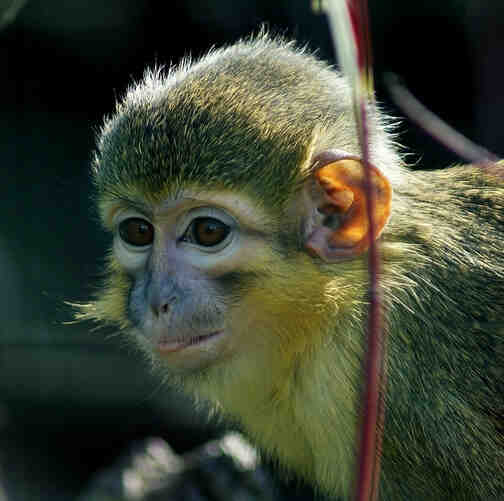Miopithecus talapoin
IUCN
LCBasic Information
Scientific classification
- name:Miopithecus talapoin
- Scientific Name:Miopithecus talapoin,Foreign name Southern Talapoin Monkey,Angola pygmy monkey, southern pygmy monkey
- Outline:Primates
- Family:Cercopithecidae g.P.monkey
Vital signs
- length:About 40 cm
- Weight:1.12-1.38kg
- lifetime:About 28 years
Feature
It is one of two small monkeys of the genus Vervet.
Distribution and Habitat
The pygmy vervet monkey is found in Angola and southwestern Democratic Republic of Congo, on the southern bank of the Congo River, and on both sides of the Cuango and Kasai Rivers. It is a strictly riverine species, confined to dense evergreen forests and vegetation along the banks of the rivers, and its range is likely to be greater in areas with more woodland, because the forest belt is narrow and resources are scarce, and the density is low in areas with large cultivated areas.
Appearance
The pygmy monkey is the smallest monkey in the Old World monkey family, and is a dwarf from the same larger ancestor. Sexual dimorphism. The average head-body length is 40 cm, the average tail length is 52.5 cm, the male weighs 1380 grams, and the female weighs 1120 grams. Long tail, green upper body, but the fur color is different from the color of several other parts of the body, and there are various differences between individuals. The fur on their backs is yellow and black, and there are thick white or grayish-white bands on the ventral side. The head is round, the nose is short, and the cheeks are hairless. The nose is black, and the skin on the face is also black. The male scrotum is pink, with blue on the inside.
The snout is prominent, the two jaws are thick, there are 32 teeth, the nostrils are close together facing forward and downward, and the hands and feet have 5 fingers and toes, with flat nails, and can stand upright. There are cheek pouches for storing food, the tee
Details
Southern Talapoin Monkey (Scientific name: Miopithecus talapoin) Foreign name Southern Talapoin Monkey, is one of the two small monkeys in the genus Miopithecus, with sexual dimorphism.

Pygmy monkeys live in large groups, usually 60-100, but often gather in groups of more than 100 near villages to steal root crops, especially cassava roots. Cassava roots contain high concentrations of toxic hydrogen cyanide, and farmers leave them in the fields to allow the daytime rain to leach the poison before use. At this point, the pygmy monkeys will examine the filtered roots and eat the parts they think are safe.
Pygmy monkeys are diurnal animals, mainly arboreal, and occasionally descend to the ground to forage. Groups of pygmy monkeys sleep in trees near the river. When disturbed, they will jump into the river and swim away. Within the group, various social behaviors such as aggression, play and grooming can be seen in groups or between individuals. They go out to find food in small groups during the day. The tribe consists of several fully grown males, many females and their offspring. There are different close relationships in the group, and there is no territorial awareness and behavior. They like to play, which mostly occurs between Asian and African adults, and sometimes adults also participate. There are two types of games: wrestling, which involves grabbing and grappling, and the other is a fast chase between each other. Males tend to play more actively in the social nature of the group than females.
Because of its relatively small size, the pygmy monkey will stare at the other party when it is attacked, and use calls and rapid panting to warn the other party. Generally, it will not take extreme attack methods, and usually respond to attacks by group unity. Among all primates, this species may have the most complex way of communication. They use both vocalization and visual signals (such as body posture and expression). In addition, tactile communication can play an important role in maintaining family affection, such as grooming or touching each other. Some primates use chemical communication, especially in reproductive environments.
Like other primates, pygmy monkeys have cheek pouches, which are located on both sides of the mouth. They are a special sac-like structure that has the function of temporarily storing food. There are two advantages: in places where competition for fruits is fierce, monkeys can grab as much food as possible without being occupied by other hungry monkeys, and at the same time, enzymes in saliva help decompose toxic compounds in unripe fruits and seeds stored in cheek pouches. It is an omnivore, and its main food is fruits, seeds, aquatic plants, and it also eats insects, shellfish, bird eggs and small vertebrates.
Females have genital bulges during estrus, and breeding expectations are usually from November to March of the following year. The gestation period is 160 days, and one baby is born per litter. The offspring is quite large, and the weight of the newborn is more than 200 grams, which is about a quarter of the mother's weight. The young grow rapidly, can eat solid food within 6 weeks, and can live independently at the age of 3 months. The highest record of captive pygmy monkeys is 28 years, and the life span in the wild is still unknown.
The natural enemies of the pygmy monkey are predators, including leopards, golden cats, birds of prey, large snakes and Nile monitors. The threats facing the pygmy monkey are not currently considered serious. Although they are small and have little meat, they are occasionally a source of wild meat for human hunters. Climate change may have a greater impact on this species. The dry season is getting longer, and the dry climate is causing smaller floods, and the living habits of the pygmy monkey are also changing.
Listed in the 2008 Red List of Threatened Species of the World Conservation Union (IUCN) ver 3.1 - Low Concern (LC).
Protect wild animals and stop eating game.
Maintaining ecological balance is everyone's responsibility!








